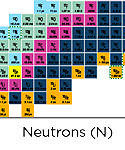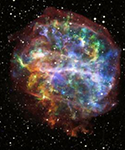For Researchers
Science at NSCL
Many departments work together to study and advance nuclear physics. The primary goal of our scientific endeavor is to unravel the mysteries that reside at the center of atoms, in atomic nuclei. A large variety of nuclei can be produced and studied at the NSCL, including nuclei with extreme neutron-to-proton ratios, and this variety provides a fertile ground for experimentation, discovery, and comparison to theory.
NSCL publications are available here.
Study of Atomic Nuclei
New work is carried out by the NSCL faculty, post-docs and students that leads to an improved understanding of nuclear phenomena in a synergetic arrangement where studies motivated by these applications help to clarify our understanding of nuclear structure and reactions. In particular, interesting new phenomena are emerging from studies of nuclei with a pronounced excess of neutrons. The most extreme cases at the neutron drip line are only weakly bound and do not have bound excited states. Our measurements of the properties and reactions of such exotic nuclei provide insight into the nuclear many-body problem, and help to understand the nature of pairing, and how the locations of nuclear binding change at extreme neutron-to-proton ratios. Read more about Atomic Nuclei here.
Nuclear Astrophysics
Nuclear physics and astronomy are inextricably intertwined. Now more than ever, astronomical discoveries are driving the frontiers of nuclear physics, while our knowledge of nuclei is driving progress in understanding the universe. Discovering the mechanism by which collapsing stars explode into supernova, understanding the processes involved in creating the elements and gaining insights into the nature of neutron star matter are all questions that are explored through nuclear physics. Read more about Nuclear Astrophysics here.
Fundamental Symmetries and Interactions
Symmetry concepts play an important role in physics. Symmetries under global transformations give rise to conservation laws and symmetries under local transformations generate the fundamental interactions. The interplay of the strong, the electromagnetic and the weak interactions in atomic nuclei offer a rich diversity of systems and processes to test fundamental symmetries as a mean to search for new interactions. Read more about Fundamental Symmetries here.
Quark Gluon Plasma
When heavy ions are smashed into each other in the most powerful accelerators in the world, bonds between the most basic particles in the universe are broken and a superhot mixture freely interacting quarks and gluons results. NSCL has faculty that works on these types of experiments as well as the theoretical calculations and theory required to try to understand the most basic workings of the universe and the evolution of the universe mere moments after the Big Bang. Read more about Quark Gluon Plasma here.
Accelerator Physics and Engineering
Producing the rare isotopes needed for all of the experiments at the laboratory requires excellence in many fields. Theoretical ideas are translated to engineering plans that must become reality in order to push the boundaries of nuclear exploration. Fields striving to improve the hardware that makes discoveries possible include physics, design, engineering, controls, operations and applications of modern accelerators. Included in this fold are ion sources, production targets and cryogenics. Read more about Accelerator Physics here.
Applied Isotope Science
With all of the research delving into the fundamental structures and processes of the universe, there is a host of potential applications of discoveries to everyday life. To name a few examples, rare isotopes can be used to develop new medical diagnostics and treatments of disease. The research at NSCL also will play an important role in understanding small-scale objects by providing isotopes for implantation and hence probing subtle effects on the atomic scale. Finally, understanding how nuclei interact is essential to national security and design of a new generation of safer nuclear reactors. Read more about Applications here.





